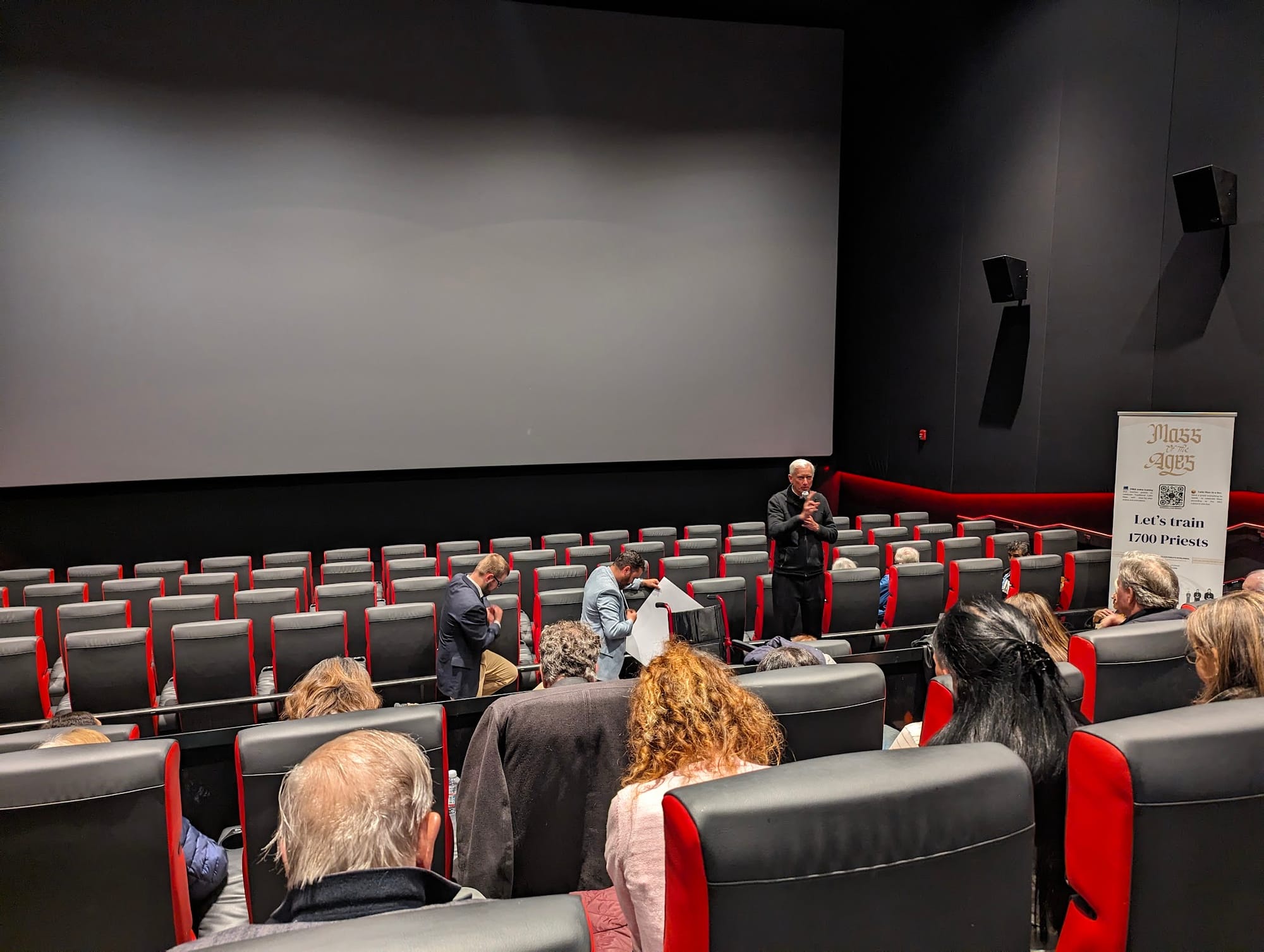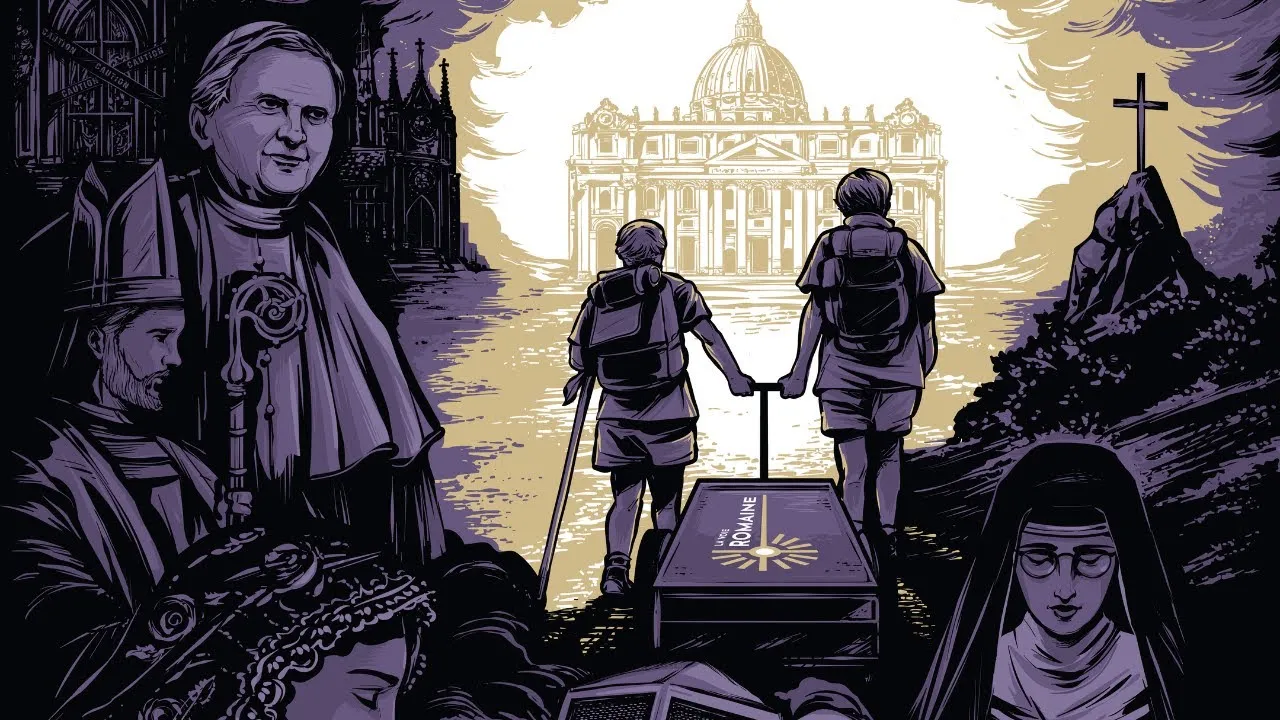The last entry in the “Mass of the Ages” documentary trilogy has been released, a 90-minute foray into the effort of Catholics around the world to foster devotion to—and restoration of—the Traditional Latin Mass, following restrictions first implemented by Pope Francis in 2021.
I attended a screening of “Mass of the Ages: Guardians of Tradition” on Tuesday in San Francisco, a lesser known hotbed of Catholic traditionalism. There it's spurred on mostly by the community at Star of the Sea Catholic Church in the city’s Richmond District, led by the church’s longtime pastor Fr Joseph Illo.
Illo was on hand with the “Mass of the Ages” filmmakers at Regal Stonestown Galleria with many of his parishioners as well as some who were simply interested in learning more about the TLM. You could say it has lost ground in recent years, but it remains a steady devotion of many conservative Catholics who, at least at times, happen to have a bone to pick with the Holy Father and with the Church as it exists in the 21st century.
Such grievances are on display in the new film, a narratively choppy but visually slick production from Horselord Films. It clearly had high-powered backers and reflects a spirit of resistance that has characterized much of the modern attachment to the centuries-old Mass.
“We believe that the Latin mass is going to be saved,” proclaimed producer and assistant director Cameron O’Hearn, who traveled from Texas to be at the San Francisco screening.
“Not because we're doing anything great but because the Lord loves it and the Holy Spirit has designed it and he has already won. But he uses us as instruments.”
Those familiar with this brand of triumphalism in the first two MOTA iterations will be in for no surprises with part 3. It likewise aims to lionize Latin Mass attendees and inveigh against “Traditionis Custodes” (TC), Pope Francis’ landmark move to rein in the TLM community by restricting their ability to use it as an escape from the Catholic Church at large.
The film gives short shrift to Rome’s actual reasoning behind TC, quoting little more than a sentence or two before unloading layers of commentary from theologians, parishioners, priests, and Catholic apologists who try to make the case that the document was a mistake and should be reversed.
Interestingly, the film is less interested in attacking Pope Francis directly than it is in casting aspersions on his advisors, who go entirely unnamed in “Guardians of Tradition.” It is alleged, if not assumed, that the episcopal survey leading up to TC was a mishandled, or even a part of a double deal on the part of the Congregation for the Doctrine of the Faith under Cardinal Luis Ladaria Ferrer. Interestingly, the Jesuit prefect was a holdover from the reign of Pope Benedict XVI, who is nevertheless presented in cloyingly favorable light in the new film.
To back up the argument that Latin Mass attendees really are just good and sincere Catholics, the film presents a wave of devotees who describe the TLM as life-changing, a revelation from which they were kept for years as Catholics attending the Novus Ordo—the liturgy of virtually all the world’s Western Catholics since the late 20th century.
Front and center in “Guardians” are a group of elderly French women who lament the fate of the TLM under Pope Francis in light of their family members who are or were priests in traditional religious orders and communities. The film highlights the women's passion, emotion, and determination as they embark on a walking pilgrimage to Rome to present their case—and thousands of petitions—to Pope Francis in a bid to have TC reversed.
“Guardians” tries its best to present the good side of Catholic traditionalism, with the stated idea that if Pope Francis could just see and interact with the bustling TLM congregations and converts, he would think twice about his decision to restrict the liturgy they love.
There is the pesky fact, of course, that it was the toxicity of many (or most) TLM communities that brought about the pontiff’s motu proprio—and the further restrictions that followed when many Western bishops refused to implement the restrictions.
The film takes this resistance as evidence that the worldwide survey of bishops must have been tampered with, since so many bishops actually are in favor of keeping the Latin Mass as-is in their diocese. It would seem, however, that like many pet issues of Western Catholics, it’s really a matter of self-selection among conservative White voices.

“Guardians of Tradition” does shake up the narrative somewhat by including non-White interlocutors from Latin America and Africa, but they are far outnumbered by the White “experts” and laypeople who seem to be the real subjects (and audience) of the documentary.
Moreover, if the filmmakers wanted to convince the audience that most TLM-goers are in fact level-headed folks who do not reject the Second Vatican Council, Pope Francis, or the world’s standard Catholic practice, they didn’t do themselves any favors.
Instead, they trot out a who’s who of dissent, from Dr. Peter Kwasniewski to Bishop Athanasius Schneider, Scott Hahn to Timothy Flanders, the independently problematic patriarchy advocate Timothy J. Gordon, and even the ousted Bishop Joseph Strickland—formerly of the Diocese of Tyler before his screeds against Pope Francis and the Vatican were deemed too much to ignore.
This is not even to speak of the film’s eye-wideningly soft treatment of the Society of St. Pius X, the group formed by the late Bishop Marcel Lefebvre before his decision to take them into schism with his illicit consecration of new bishops without approval from Pope St. John Paul II. Current SSPX members are portrayed as all but victims in “Guardians,” merely a Traditionalist group waiting to be welcomed back into regular canonical status by the Holy See. The society did not allow its members’ interviews to appear in the film, but the message was clear enough.
The hardest element for me to fathom, though, was the tendency of the lesser-known figures in the film, the grandmas and couples and the like, to repeatedly speak of the Latin Mass as an entity unto itself. “What would we do without it?” they ask over and over. You’d think they would just, you know, go to Mass somewhere else, but no. They speak as though this were an impossibility—implying that they do in fact reject the Novus Ordo, which is exactly how “Traditionis Custodes” describes problematic Traditionalist ideology.
That said, the film had moments of potential. I wish it had delved more into the Black Catholic narratives barely brushed by in the the story arc. These included a brief stop at the headline-making monastery founded by the late Benedictine nun Mary Wilhelmina Lancaster in Missouri, and multiple scenes with a couple from the Oratory of Ss. Gregory & Augustine in St. Louis, where the rector—seen but not interviewed in the film—is Msgr Eugene Morris, one of the nation’s few African-American TLM priests.
It’s not that I agree with either figure in life or death, but it would have been nice to see what an African-American Catholic has (or had) to say about why they gravitated toward a decidedly Eurocentric form of the Catholic Mass. Alas, we are left to wonder.
There were, on the other hand, interviews with an African priest in Kenya and several lay Catholics, including children, who appear to be his parishioners. The laypeople depicted are not devotees of the Latin Mass. In fact, they admit to knowing little to nothing about it. They are nevertheless asked how they feel about it, instead of what they know. They respond positively.
The scene is attractive, however, in that it displays the people’s indigenous Catholic culture, including their music and dancing, in juxtaposition with a Latin Mass celebrated by Bishop Schneider, who is there on a visit. It’s something that you’d hardly ever see in America, where the Latin Mass crowd is so often hostile to much of Black culture—especially the idea of it appearing in a traditional liturgical context.
“Guardians” also displayed glimmers of (perhaps unintentional) honesty, with the St. Louis couple—now Latin Mass devotees—admitting that their first experience at a TLM was a display of stereotypically conservative judgmentalism and rejection.
These nuggets are not interrogated in the film, and it is taken as a given that the Latin Mass has no less than a miraculous character on its own, over and against all alternatives. Similarly to how many Catholic converts to Protestantism speak as if they were never baptized Christians before, cradle-Catholic interviewees in the new documentary speak in such a way that viewers would be forgiven for thinking they had never really known God in their Novus Ordo lives.
To be fair, though, I wouldn't know. Perhaps they didn’t. But was that the fault of the Mass that most saints of the 21st century will have attended their entire lives? More basically, in the vortex of post-Vatican II narratives on authentic Catholic renewal, in which “Guardians” paints itself as a robustly reasonable tour de force, does correlation equal causation?
If not, maybe we needed a quite different sort of film here.
Nate Tinner-Williams is co-founder and editor of Black Catholic Messenger.










